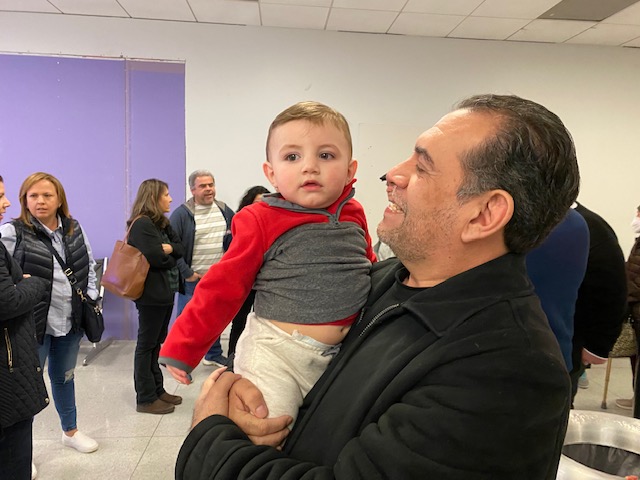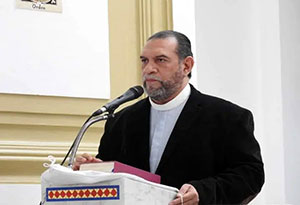 Father Tijerino meets his infant nephew Eduardo after arriving at the Charlotte airport Sunday night. (Photos by Liz Chandler)
Father Tijerino meets his infant nephew Eduardo after arriving at the Charlotte airport Sunday night. (Photos by Liz Chandler)
CHARLOTTE — Two Catholic priests imprisoned in Nicaragua since August arrived in Charlotte to hugs and tears from family and friends on Feb. 12, after their recent release and deportation to the United States.
Fathers Ramiro Tijerino and Óscar Danilo Benavides Dávila, both of Nicaragua, were among 222 political prisoners exiled from the country by President Daniel Ortega.
Mayra Tijerino, a parishioner at St. Matthew in Charlotte, flew to Washington, D.C., to bring her brother and his fellow priest to her home in the Charlotte area.
The pair met with Charlotte Bishop Peter Jugis and other diocesan leaders Feb. 14, as the two men adjusted to their newfound freedom. In their first 48 hours, they also visited a doctor, enjoyed a steak lunch, shopped for clothes and shoes, and were outfitted with new black clerics, courtesy of Deacon Carlos Medina, who immigrated from Nicaragua years ago.
St. Matthew parishioners immediately went to work preparing a birthday celebration for Father Tijerino, who turns 51 on Feb. 16. The parish has been praying for him and his fellow political prisoners since their imprisonment last August, and shared the good news of the two priests’ return at recent Masses.
Two dozen well-wishers turned out to greet the priests at Charlotte-Douglas International Airport.
“I am thankful to God,” Father Tijerino’s mother, near tears as she and her husband positioned themselves at the bottom of the airport escalator that would soon deliver their son.
“He’s coming!” a boy cried, spotting Father Tijerino, his uncle, descending toward him.
Well-wishers unfurled blue-and-white Nicaraguan flags as they greeted the priests, who appeared generally fit – and all smiles.
“There were some hard months but thanks to God and the prayers of this parish, we were given the strength to endure,” Father Tijerino said, working his way through a receiving line in baggage claim.
Father Óscar Danilo Benavidez Dávila was embraced as if he were family, too. “God bless the parish,” he said. “I am grateful to this diocese, and to the parish, and to the faithful whose prayers sustained us.”
Both priests said they were not physically mistreated in prison but noted emotional and psychological stress caused by such tactics as leaving the lights on for two straight months, then off for a month.
 Father Ramiro Tijerino (provided photo)“They gave us food,” Father Tijerino said, “and the medical care wasn’t the best, but it was there.”
Father Ramiro Tijerino (provided photo)“They gave us food,” Father Tijerino said, “and the medical care wasn’t the best, but it was there.”
Father John Allen, parochial administrator of St. Matthew Parish, hugged his fellow priests and pledged to help with anything they needed. He is planning a Mass of Thanksgiving at an appropriate time.
“Today is a joyous day for their family and friends, and we look forward to celebrating with them at St. Matthew,” Father Allen said. “As witness to the power of prayer, we will continue to pray for Bishop Álvarez who remains imprisoned and in danger.”
Bishop Rolando Álvarez, an outspoken critic of Nicaragua’s government, was sentenced to 26 years in prison Feb. 10 on charges of undermining the government, according to news reports – one day after he refused to board the flight to the United States with other prisoners.
In his message Feb. 12, Pope Francis invited the faithful to pray and expressed sadness over the continued detention of Bishop Álvarez. He issued an appeal for Nicaraguan leaders “to open their hearts” in search of peace and to engage in dialogue.
Seven “collaborators” of Bishop Álvarez – including Father Tijerino – were also given lengthy prison sentences last week, then suddenly released after what the U.S. government said were concerted diplomatic efforts.
As an independent institution trusted by a large portion of Nicaraguans, the Church is a threat to Ortega’s increasingly authoritarian rule. Student protests intensified last spring and numerous Catholic and other religious leaders were among those detained during a crackdown last summer.
“I am grateful to God for bringing me here, and I am happy to see my family,” Father Tijerino said Sunday, kissing an infant nephew, Eduardo, he was meeting for the first time.
“I knew I would see them again – I just didn’t know when. I want to thank the Catholic community of Charlotte for their prayers of support for me, and I hope we will remember and continue to bring strength to the prisoners who remain in Nicaragua.”
— Liz Chandler. Photos by Liz Chandler nd SueAnn Howell.
RELATED NEWS: After priest's arrest in Nicaragua, Charlotteans pray for peace
















